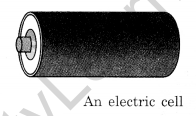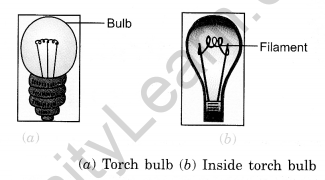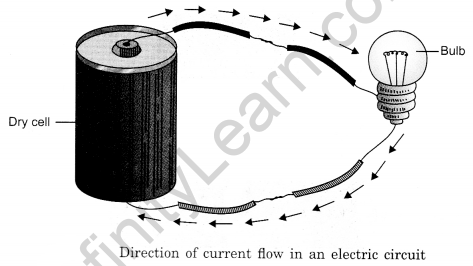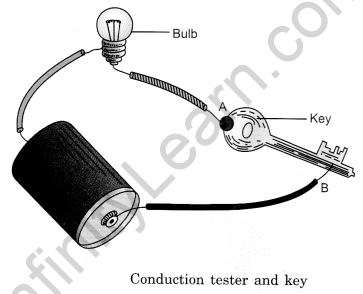Table of Contents
Electricity and Circuits Class 6 Notes Science Chapter 12
Explore the interesting chapter of Electricity and Circuits with our Class 6 Science Chapter 12 notes. We’ve created these notes keeping in mind the CBSE syllabus, aiming to make the learning process both enjoyable and straightforward. We break down complex concepts into easy-to-understand explanations. Our goal is to provide you with a reliable resource that ensures a comprehensive understanding of the topic.
Power station: Electricity that we use at homes, in our factories, is supplied from a power station.
Electric cell: Electric cell is a source of electricity.
Production of electricity in a cell: An electric cell produces a small amount of electricity from chemicals stored inside it. When the chemicals in the electric cells are used up, the electric cells stop producing electricity.
Terminal: All types of electric cells have two terminals, a positive terminal and a negative terminal. In a dry cell used in our homes, the central carbon rod is the positive (+) terminal and the zinc contained in the negative (-) terminal.

Battery: When two or more cells are joined together, the combination is called a battery.

Bulb: We get light from a thin tiny wire inside the glass cover. This is called a filament. It is supported by two thicker wires, as shown in Fig. One of these thick wires is connected to the metal casing around the base of the bulb. The other is connected to the metal tip of the base. The base of the bulb and the metal tip of the base are the two terminals of the bulb. These two terminals are fixed in such a way that they do not touch each other.
The inside portion of the bulb is filled up with inert gases, like argon.

Circuit: The complete path, from one terminal of the electric cell through the bulb and back to the other terminal of the electric cell, is called a circuit.
Open circuit: If there is any gap in the path of a circuit, the bulb does not light up. Such a circuit is called an open circuit.
Closed-circuit: The bulb lights up only when a bulb and wire form a complete path, which starts at one terminal of the electric cell and ends at the other terminal. Such a circuit is called a closed circuit.
The flow of current in a circuit: As soon as the path from one terminal of the electric cell to the other is completed, an electric current starts flowing through the circuit and the bulb lights up. The electric current flows from the positive terminal of the electric cell to its negative terminal.

In the bulb, current enters through one of its terminals flows through the filament inside the bulb and comes out through the other terminal of the bulb. When the current flows through the filament, it starts glowing.
Fused bulb: If the filament of the bulb is broken, the circuit is not completed and hence the current cannot flow. The bulb with a broken filament is called a fused bulb. When a bulb gets fused, it does not light up.
Electric switch: Electric switch is a simple device that either breaks the circuit or completes it to stop or start the flow of current.
- When the switch completes the circuit, it is called a closed switch.
- When the switch breaks the circuit, it is called an open switch.

Conductors
- Materials through which electric current can flow are called conductors.
- Most metals are conductors.
- Our body is also a good conductor.
Insulators
- Materials, through which the electric current cannot pass, are called insulators. In other words, insulators are the bad conductors of electricity.
- Rubber and wood are insulators.
| Class 6 Related Links | |
| NCERT Syllabus for Class 6 | NCERT Solutions for Class 6 English |
| NCERT Solutions for Class 6 Social Science | CBSE Notes Class 6 |
| NCERT Solutions Class 6 | Worksheet for Class 6 All subjects |
| CBSE Class 6 Science Syllabus | NCERT Books for Class 6 |
| NCERT Solutions Class 6 Maths | CBSE Class 6 Social Science Syllabus |
| CBSE Class 6 English Syllabus | Online Tuition for Class 6 |
Conduction tester: It is a simple device to test whether a material is a conductor or insulator.

Filament: The thin wire that gives off light is called the filament of the bulb.
Dry cell: Dry cell is a source of electricity. It generates direct current (DC) due to a chemical reaction that takes place inside it.
Bulb: An electric bulb is a device that glows and emits light when an electric current is passed through it.
Conductors: Materials that allow an electric current to pass through them are called conductors.
Electric cell: Electric cell is a source of electricity.
Electric circuit: The complete path from one terminal of the electric cell through the bulb and back to the other terminal of the electric cell is called an electric circuit.
Filament: In an electric bulb, there is a thin tiny wire inside the glass cover. This is called a filament.
Insulator: Materials that do not allow an electric current to pass through them are called insulators.
Switch: Electric switch is a simple device that either breaks the circuit or completes it to stop or start the flow of current.
Terminal: All types of electric cells have two terminals, a positive terminal and a negative terminal.
Life without electricity is difficult to imagine. Many devices and machines in our day-to-day lives run on electricity.
Look at the pictures given below. Which of these run on electricity? Write their names in the space provided.
Things that run on electricity have electric currents passing through them. In this, chapter, you will learn about electric current, what is needed to produce it, the conditions required to make an electric current flow, and the materials through which current can flow. You will learn some very interesting things like how to make a small bulb glow and how to make an electric switch. Answers: Refrigerator, Fan.
Electric Current
Most of the devices and machines we use like an electric iron, oven, room heater, refrigerator, ceiling fan or an electric bulb work when an electric current flows through them.
With help from an adult, look at what is inside a transparent electric bulb (Fig. 14.1). Among other things, you will see that it has a thin filament (a very thin metal wire). The filament heats up when an electric current is passed through it. It heats up so much that it begins to glow and give out light.
Now, we will learn what produces an electric current.
Source Of Electric Current
A device that can be used to produce an electric current is called a source of electric current. Common sources of electric current are cells and batteries (collection of cells) which comes in various shapes and sizes (Fig. 14.2), an electric current that we get from plug points in houses. A very useful kind of cell which we use very often is the dry cell. Due to a chemical reaction that takes place in cells and batteries, an electric current is produced.
For large-scale production of electricity, flowing water or steam is used.
The Dry Cell
A dry cell is a very convenient source of electric current. The dry cell, as its name suggests, contains dry or semi-solid ingredients.
Let us take a look inside a dry cell [Fig. 14.3(a and b)].
The dry cell contains a paste of ammonium chloride inside a zinc container. Inside the paste, a cardboard container containing powdered manganese dioxide and carbon is placed. The cardboard container has microscopic ‘holes’ in it (such materials are called porous materials) through which a chemical reaction takes place between ammonium chloride paste and powdered manganese dioxide. A rod, usually carbon, with a metal cap is dipped into the manganese dioxide. The whole thing is then sealed (with only the metal cap sticking out) so that the contents do not spill out.
The zinc can is also wrapped so that only the base is exposed. Every source of electric current has two ends or terminals where conducting wires are connected to draw electric current. The tip of the metal cap and the base of the zinc can are called the positive and negative terminals of the dry cell, respectively. Electric current can be thought of as ‘flowing in’ from one terminal and ‘flowing out from the other. If the tip of the metal cap and the base of the zinc can are connected by a metal wire, the current will flow through it.
Different Types of Electric Cells:
Apart from the simple primary cells like dry cells, there are different types of electric cells. Different cells use different methods for producing an electric current. Primary cells can be used only once, and have to be thrown away once they have been used up.
Some cells can be recharged once they are drained. These are called secondary cells. They are used in mobile phones, laptops, and car batteries.
Nowadays, solar cells are being used in many applications. Solar cells use sunlight to produce an electric current. Fig. 14.4 Some devices that work on dry cells.
Many calculators are powered by solar cells. Solar panels made up of solar cells are used to light up streets and many homes.
Flow Of Electric Current
Three basic conditions (Fig. 14.5) are required for an electric current to flow.
- A device used to produce an electric current like a cell, battery, or plug point acting as a source.
- A wire made of a metal like copper, silver, or aluminium, which will allow an electric current to flow through easily.
- An unbroken loop (of the wire) running from one terminal of the source, through various appliances, back to the other terminal of the source.
Making a Simple Electric Circuit:
When we connect the terminals of a pencil cell (the name given to the cell due to its shape) to a bulb using two wires, the bulb glows. This happens because we provide a path for the current to flow. A path for an electric current to flow is called an electric circuit.
In Figure 14.6(a), one wire from the pencil cell is connected to the torch bulb, while the other wire is not. The electric circuit is not complete here. In Figure 14.6(b), both the wires from the cell are connected to the torch bulb. The electric circuit is complete in this case. Electric current flows only if there is an unbroken path or closed circuit starting from one terminal of the source, through the torch bulb, to the other terminal of the source. Thus, the bulb glows in Figure 14.6(b) but not in Figure 14.6(a). The circuit in Figure 14.6(a) is not complete. Hence, current cannot flow through the circuit and the bulb does not glow. Such a circuit is called an open circuit. The circuit in Figure 14.6(b) is complete. Electric current flows through the circuit and, as a result, the bulb glows. Such a circuit is called a closed circuit.
Electric current flows in a particular direction. In an electric circuit, the electric current flows from the positive terminal to the negative terminal of the electric cell. Figure 14.7 shows the direction of the flow of electric current in a circuit.
Electric Switch
We use electric switches (Fig. 14.8) to put on or off the electrical devices and machines. But do you know how it works?
An electric switch is a device that is used to open or close an electric circuit. When we open an electric circuit, the flow of electric current in the circuit stops [Fig. 14.9(a)], and when we close an electric circuit, an electric current flows through it [Fig. 14.9(b)]. In an electrical circuit, a switch is sometimes.
Electric Torch
A schematic diagram of an electric torch is shown in Fig. 14.10. An electric torch has one or more dry cells inside it, which act as the ‘source’. These cells are connected through a switch to a small bulb. When the switch is pushed to the ‘on’ position, the circuit is complete and the bulb glows. When the switch is pushed to the ‘off’ position, the circuit is incomplete (broken). Now the current cannot flow through the circuit, and the light goes out.
Conductors And Insulators
Look at Figures 14.11(a)-(d). Each shows a complete electric circuit. Then why is it that the bulb glows only in circuits (b) and (d)? It is because not all materials allow an electric current to pass through them.
A material that allows electric current to pass through it is called a conductor of electricity like the key and the safety pin [Figs. 14.11(b) and (d)]. A material that does not allow an electric current to pass through it is called an insulator of electricity like the rubber band and the plastic pen [Figs. 14.11(a) and (c)].
All metals are conductors of electricity while some are better conductors than others. A few non-metals like graphite (pencil lead is made of graphite) are also conductors of electricity.
Examples of insulators are glass, wood, rubber, pure water, and dry air. However, the smallest impurity in water (impurities are substances like salts, dissolved in water) makes it a conductor.
The handles of screwdrivers and testers used by electricians are usually made of wood or hard plastic. They also wear rubber gloves while repairing an electric switch to avoid electric shock.
Electrical Safety
Electricity can be very dangerous if you do not handle electrical devices carefully. One should never play with electrical wires and sockets. Electricity from cells is safe and you can experiment with it, but you have to be careful not to connect the two terminals of a cell directly through a wire/conductor. Electricity generated by portable generators is dangerous and should not be used for experiments.
Source of electric current: A device that can be used to produce an electric current is called a source of electric current.
Electric circuit: A path for an electric current to flow is called an electric circuit.
Closed-circuit: A circuit that has an ‘unbroken path’ through which an electric current can flow is called a closed circuit.
Open circuit: A circuit with a break in it is called an open circuit.
Electric switch: A device that is used to open or close a circuit is called an electric switch.
Conductor (in this chapter): A material that allows electric current to pass through it easily is called a conductor.
Insulator (in this chapter): A material that does not allow an electric current to pass through it easily is called an insulator.
In a dry cell, a chemical reaction takes place to produce an electric current.
A dry cell contains solid or semisolid ingredients.
All cells have two terminals: the positive and the negative terminal.
Electric current flows only if there is an unbroken or complete path, starting from one terminal of the source, through various devices back to the other terminal of the source.
An electric switch is a device that is used to open or close a circuit.





